Here we discuss the following points:
Card Ranking
Ace, King, Queen, Jack, 10, 9, 8, 7, 6, 5, 4, 3, 2
(Ace can be high or low when making a straight)
Card Suits

There are 52 cards in the deck, plus 2 Jokers. You do not play Texas Hold’em with Jokers.
What you need to start playing:
- 2 Decks of cards (This will keep the game moving quickly since one deck can be shuffled while one deck is being used. Choose decks that are different colors since they will be easier to tell apart. You will only be playing with one deck at a time.)
- Playing chips with at least four color denominations
- Dealer button
- Big and small blind buttons
- A ranking of the hands
- A timer
- 5 to 10 players
- Table with soft surface (felt or table cloth)
- You favorite snacks and drinks
Before the Game
- Invite 5 to 10 players. A great idea is to create an evite or a Facebook invite.
- Decide if you will be playing a tournament style game or a “cash” game. In a tournament, players all begin with the same number of chips and play continues until only one person is remaining. Once players lose their chips, they are out of the game for the night. The winner receives all the cash or you can divide the cash between the first, second and third place winners. A cash game is a much looser style of play. Players can purchase as many chips as they would like for a specific value and can continually “rebuy” more chips as the game continues. All players receive the cash value of what they have in chips at the end of the game.
- Decide on your chip count. It helps to have this information displayed for players during the game. Below is a guideline for getting started:
| # OF CHIPS | CHIP VALUE | TOTAL VALUE |
|---|---|---|
| 8 | 25 | 200 |
| 6 | 50 | 300 |
| 5 | 100 | 500 |
| 2 | 500 | 1000 |
| 21 | 2000 |
- Decide ahead of time what your tournament’s entry fee will be. You can structure it as winner-take-all or offer a first, second and third prize structure.
- If you have any beginners, you will also want to provide a best-hand cheat sheet ranking the hands from high to low. These are available in our store.
- You will need to decide who will be the dealer. A great way to do this is to place playing cards facedown on the table and have players draw one each. The number of cards should correspond with the number of players and include one ACE. The player who draws the Ace acts as the first dealer and begins the game with the round white disk marked “dealer,” otherwise known as the “button.”
Starting the Game
- The two players to the dealer’s left are the small and big blinds. The small blind falls to the immediate left of the dealer and the big blind to the left of the small blind. The action, the blinds and the dealer button always move one seat to the left before each hand. Think of a really big clock. Clockwise, clockwise, clockwise!!! The button and blinds move after every hand.
- The blind levels slowly increase as the game progresses. Basically, the size of the blinds and the rate at which they go up determines how long your tournament is going to take. Usually 20-mminute increments or “levels” work well. During the first 20 minutes, the blinds would be 25 and 50, meaning 25 for the small blind and 50 for the big blind. In the second 20-minute increment blinds would go up to 50 and 100. See the table below for a standard betting structure for a tournament:
| LEVEL | SMALL BLIND | BID BLIND | ANTES |
|---|---|---|---|
| 1 | 25 | 50 | |
| 2 | 50 | 100 | |
| 3 | 100 | 200 | |
| 4 | 200 | 400 | |
| 5 | 300 | 600 | |
| 6 | 400 | 800 | |
| 7 | 500 | 1000 | 25 |
| 8 | 600 | 1200 | 25 |
| 9 | 700 | 1400 | 50 |
| 10 | 800 | 1600 | 50 |
| 11 | 900 | 1800 | 100 |
| 12 | 1000 | 2000 | 100 |
Note: Antes are forced bets that are placed by each player at the table for each hand played. Antes are placed whether or not a player decides to fold. If you fall on the small or big blind during a round with antes, you are responsible for the blind bet PLUS the ante. Ants begin at Level 7.
Playing the Game
The objective of the game is to make the best 5 card hand combining your 2 “hold cards” and the 5 community cards face-up on the board. You can do that by using t2 cards from your hand and 3 from the board, 1 card from your hand and 4 from the board, or the 5 cards on the board.
- Now you are ready to SHUFFLE UP and deal. Hit the timer on the clock and make sure the dealer has shuffled the deck. The player who is the dealer deals one card face down to the player to her left and then one card to each player at the table, going around clockwise and dealing to themselves last. Then a second card is dealt to each player face down in the same order. These cards are your starting hand, also know as your “hole” or “pocket” cards. Once every player has 2 cards facing down, the first round of betting begins. DON’T SHOW ANYONE YOUR CARDS!!!!!
- The first bet before the flop begins with the player to the left of the big blind. In the subsequent rounds of bettering after the flop, the first player to act is the one to the left of the dealer who is still in the hand.
- The three options for players before the flop are as follows:
- CALL – To match the big blind bet (in this case 50 points in chips).
- RAISE – To increase the bet. A RAISE must be at least twice the big blind (in this case 100 points in chips or more). If you are playing no-limit, you can always bet the value of your whole stack.
- FOLD– To discard your cards and be out of the hand.Each player chooses one of these three options by first looking at her starting hand and making a decision based on the strength of her cards and the perceived strength of her opponent’s hands. The play moves around the table clockwise. Once the play makes it way around the table and moves to the small blind player, that player must either add more chips to meet the big blind in order to stay in the hand, raise that bet, or fold. If the small blind player folds, they forfeit their small blind bet. Once the play moves on to the big blind player, that player can either stay in the hand byCHECKING if no one else has raised by knocking one’s hand on the table to signify that the forced bet they have placed is enough, CALLING if a previous player has raised by adding enough chips to the pot to meet the current bet of a previous raiser, or they can raise, or fold. The play continues around the table until the highest bet or raise has been called or folded by everyone. (The Big Blind should NEVER fold if no one else has raised since this will enable you to see a flop for no additional chips. You never know how a FLOP can hit a BIG BLIND.)
- After each player has made their choices, all the chips are placed in the middle of the table, which is called the POT. The DEALER then discards one card facedown (called the BURN card) and then deals the first 3 community cards face up for the entire table to see. This called the FLOP.
- A second round of betting begins starting with the player to the dealer’s left. The betting moves around the table until each player has made their decision. If someone at the table raises, each player must meet that bet in order to stay in the hand. After the flopplayers’ options are:
- CHECK – Essentially a bet of zero chips. You can only check if no one before you has bet.
- BET – The minimum bet that can be made is the amount of the BIG BLIND.
- CALL – Matching the previous highest bet which is the minimum amount required to remain in the hand.
- RAISE – The raise must be at least DOUBLE the size of the last bet.
- FOLD – To discard your cards and be out of the hand.
- Once the play has moved entirely around the table and everyone has either called the highest raise or bet or folded, it’s time for the next BURN and TURN of the cards by the DEALER. The dealer turns another card facedown into the BURN or DISCARD pile and one community card face up next to the previous three community cards. This is known as FOURTH STREET or the TURN. After the turn, another round of betting takes place following the same procedure as after the FLOP.
- Finally, the last two cards are BURNED and then TURNED by the dealer. The dealer turns another card facedown into the BURN or DISCARD pile and turns the final community card up next to the TURN. The 5th community card is known as FIFTH STREET or the RIVER. Now each player makes his or her final bet or action. The player left in the hand turn-up their cards and the player with the best 5 card winning hand wins the pot. In some instances, the chips may be divided evenly among one or more tied winning hands. (NOTE: A sixth card is NEVER used to determine a tie.)
- The player, who wins the hand, wins the chips in the pot. The cards are then collected. The dealer button is moved one spot to the left, as are the small and big blind bets. The player who was the small blind becomes the dealer and the player who was the big blind becomes the small blind, etc. The cards are reshuffled, and the deal continues as mentioned above.
- ALL IN! Once a player has lost of their chips, she is out of the tournament. The player who has the most chips at the end wins. You can play until there is only one player left with all of the chips, or you can set a time for the game to end and count the chips at that point.
Poker Betting Terms
| Check | Pass-if no bets have been placed then a player can opt to make no wager and the turn is passed to the player on her left. |
| Bet | Make a wager. |
| Call | Make a wager equal to the current bet size. |
| Raise | Make a wager equal to the current bet size plus an additional wager. |
| Fold | Throw in your hand and forfeit the game. |
| Check Raise | To check your hand and then raise when a player after you bets. Particularly useful where you need extra strength to narrow the field when you have the best hand. |
| Blinds | A forced bet put in by one or more players before any cards are dealt. The two players immediately to the left of the button put in blinds. The first player to the left is the small blind. The next player to the left is the big blind. |
| Button | An acrylic disk that indicates who is the dealer. Also used to refer to the player on the button. Example: “Oh, the button raised.” The button position rotates clockwise every hand. |
| Position | Where you are sitting in relation to the button. |
Hand Ranking
Pictured below are the hands of poker, listed in order from highest to lowest.
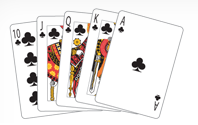
1. Royal Flush
Ten, Jack, Queen, King, Ace of the same suit.
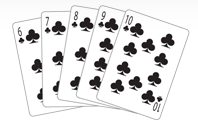
2. Straight Flush
Straight with all five cards in the same suit.
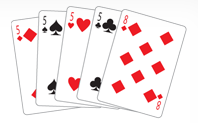
3. Four of a Kind
Four cards of the same number or face value (“quads”).
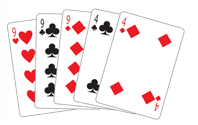
4. Full House
Three cards of one number or face value and two cards of another. The full house with the highest ranking three of a kind wins.
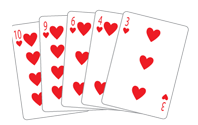
5. Flush
Five cards of the same suit. If there is more than one flush, the hand with the highest card(s) wins. This is an Ten high flush.
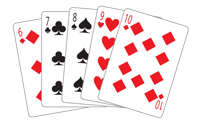
6. Straight
Five cards in sequence. Cards can be in any suit. An Ace can be used in the highest straight (10, J, Q, K, A) aka “Broadway” and the lowest straight (A, 2, 3, 4, 5) aka “The wheel”.
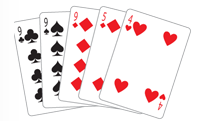
7. Three of a kind
Three cards of the same number or face value otherwise known as (“trips” or a “set”).
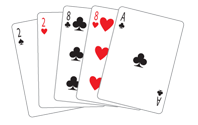
8. Two Pair
The highest pair wins. If two players have the same high pair, the second highest pair wins. If they have the same two pair, whoever has the highest fifth card (“kicker”) wins. 8′s over 2′s with an Ace kicker.
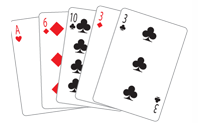
9. Pair
Two cards of the same number or face value. If two players have the same pair, the highest outside card(s) (kicker) wins. In this case Pair of 3′s, A kicker.
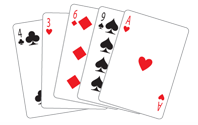
10. High Card
The hand with the highest card(s) wins. In this case Ace is high card.







